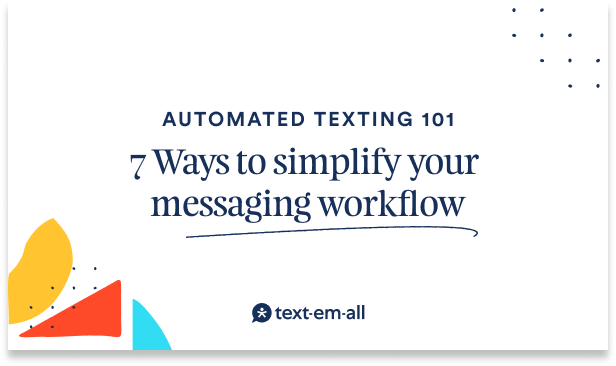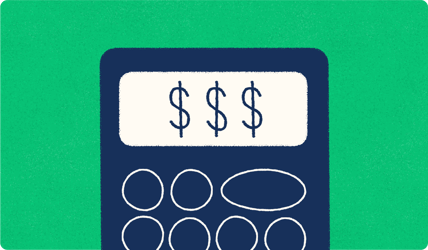8 min read
Automated texting 101: 7 Ways to simplify your messaging workflow
![]() Ron Kinkade
:
Oct 20, 2025
Ron Kinkade
:
Oct 20, 2025

It's Monday morning, and your team is already handling dozens of appointment confirmations, schedule updates, and follow-up messages. Customer service reps are typing the same reminder texts over and over, while operations staff copy-paste event updates to different groups throughout the day.
This scenario happens at most organizations that use text messaging for customer communication. Many businesses start with manual texting because it feels personal and controlled. However, there's a better approach that keeps the personal touch your customers expect while making your team much more productive.
Automated texting offers a smart solution for working smarter, not harder. Rather than replacing real conversations, it handles repetitive messaging tasks automatically, so your team can focus on the customer interactions that truly need a human touch.
What is automated texting?
Automated texting is a system that sends text messages at set times or when certain things happen – all without needing someone to manually send each message.
Think of it like programming your coffee maker: you set it up once to brew at 6:30 AM each morning. Similarly, you can schedule appointment reminders to automatically send 24 hours before each booking, or create welcome messages that introduce new subscribers to your services over several days.
The benefit is combining automation with personalization. While the system handles sending messages, each text can include personal details like recipient names, appointment times, or account information. This way, automated messages still feel tailored to each person.
Modern automated texting platforms, like Text-Em-All's automation features, go beyond basic scheduling. They support two-way conversations, meaning recipients can reply and interact naturally. For example, you might send an automated appointment reminder where customers can respond "C" to confirm or "R" to reschedule, and your system routes those responses correctly.
This creates smart communication flows that help both your team and your audience, rather than just sending messages without any way to engage.
Benefits of automating your text messages
The advantages of automated texting go far beyond simple convenience. When done right, automation changes how organizations communicate with their audiences while delivering real improvements in several key areas.
Save lots of time
The biggest advantage is getting valuable hours back for your team. When routine messages become automated, staff members can focus on complex customer interactions that really need human help instead of repetitive messaging tasks.
Industry data backs this up. Businesses using automated SMS campaigns have made up to 30× more revenue per recipient compared to one-off manual messages. This shows both better efficiency and improved business results.
Reliable and consistent delivery
Automated systems are great at precise timing. Unlike manual processes that can be delayed by busy schedules or human mistakes, automated messages deliver exactly when planned, keeping communication standards consistent across all customer touchpoints.
This reliability produces real results. Healthcare providers using automated appointment reminders have reduced no-show rates by 29–38% simply because patients consistently receive reminders at the right times. The dependable nature of automated systems makes sure important communications never get missed due to scheduling gaps.
Better engagement through smart timing
Automated texts often get higher engagement rates than manual communications because they reach recipients at exactly the right moment with relevant information.
Here's an example: when a customer finishes a service appointment, an automated follow-up text arrives one hour later asking for feedback. This timing works well – the experience is fresh in their mind, and providing input feels convenient rather than bothersome.
Since SMS messages have about 98% open rates, automation helps organizations take advantage of these strong engagement numbers by making sure messages reach audiences when they're most likely to respond positively.
Easy scaling
As contact lists grow from hundreds to thousands of recipients, manual messaging becomes hard and time-consuming. Automated texting lets organizations communicate with 10,000 people as easily as 100 – the work effort stays basically the same once workflows are set up.
This scaling ability is important for organizations that need instant mass communication. Whether you're a university sending campus-wide emergency alerts or a retailer announcing time-sensitive sales, automated systems make sure all relevant recipients get the message at the same time.
Better accuracy and following rules
Automation greatly reduces human error in messaging operations. The system delivers messages to correct recipient lists at precisely scheduled times with consistent formatting and required legal language, such as opt-out instructions.
This accuracy becomes particularly valuable for sensitive communications like payment reminders, medical appointment confirmations, or legal notifications where precision is important for both customer service and following regulations.
Easy personalization options
Modern automated texting platforms make personalization that feels genuinely tailored to individual recipients. Systems can automatically insert names, appointment details, account balances, or other relevant data into message templates.
For instance, an automated payment reminder might read "Hi Jennifer, your account ending in 1234 has a $75 payment due on October 15" to one customer, while another receives "Hi Marcus, your account ending in 9876 has a $125 payment due on October 20." Each message feels personally written despite being created automatically.
Simple analytics and improvements
Automated texting platforms typically provide detailed performance data including delivery rates, response rates, click-through numbers, and customer engagement patterns. This information helps you continuously improve your messaging strategies based on actual customer behavior rather than guesswork.
Organizations can identify which message types get the highest engagement, best sending times for different audience groups, and content approaches that drive desired actions. These insights help with broader communication strategies and help maximize the return on messaging investments.
Popular use cases for automated texting
Understanding how different organizations successfully use automated texting can help you identify the most valuable applications for your specific situation. Here are the most common and effective ways businesses use automation to improve their communication workflows.
Appointment reminders and confirmations
This represents one of the most effective uses of automated texting across multiple industries. Healthcare providers, automotive service centers, salons, and professional service firms all benefit from organized appointment management through automated messaging.
Automated appointment reminders work particularly well for appointment-based businesses – medical offices, automotive service centers, salons, and professional services. The typical setup includes immediate booking confirmation, 24-hour advance reminders, and post-appointment follow-up messages.
The measurable impact on attendance rates makes this investment worthwhile. Healthcare providers using healthcare appointment reminder best practices have documented no-show rate reductions of 29–38%, directly translating to improved revenue and better resource use.
Regular communication sequences
Organizations that need consistent daily or weekly communications benefit a lot from automated scheduling. Rather than manually sending recurring updates, teams can batch-schedule content weeks or months in advance.
Examples include fitness coaches sending daily wellness tips, construction companies sending morning safety briefings, or educational institutions sharing weekly schedule updates. The content stays consistent and reliable while removing the administrative burden of manual distribution.
Financial and billing communications
Financial communications need both precision and timeliness, making automated texting particularly valuable for payment reminders, account alerts, due date notifications, and security warnings. The immediate delivery of SMS builds customer trust by making sure time-sensitive financial information reaches them quickly.
These automated messages provide real customer value: payment reminders help avoid late fees, fraud alerts protect accounts, and balance notifications help with better financial management. The automation makes sure these critical communications maintain consistent delivery without human oversight gaps.
Event management and updates
Organizations hosting events, training sessions, webinars, or classes can maintain consistent attendee engagement through automated messaging sequences. These campaigns typically include pre-event reminders, real-time updates during events, and post-event follow-up communications.
This approach works especially well for managing last-minute changes. When events need rescheduling or cancellation, automated systems can instantly notify all registered participants, preventing confusion and keeping professional communication standards.
Emergency notifications and crisis communication
Time-sensitive situations require immediate, reliable communication channels. Automated texting systems can work with emergency management protocols to deliver critical information instantly to relevant audiences.
Educational institutions use these systems for campus safety alerts, weather closures, and emergency procedures. Healthcare facilities use automated patient notification systems for urgent updates. Since 95% of text messages are read within three minutes, SMS automation makes sure critical warnings reach recipients when timing matters most.
Customer support and information sharing
While not replacing human customer service, automated texting can handle routine inquiries through keyword-based responses. Customers can text specific words to receive instant information about business hours, locations, pricing, or frequently requested details.
Using SMS keywords and auto-replies, this application reduces staff workload for repetitive questions while providing customers with immediate access to information they need. The system can also send complex queries to human representatives when automated responses aren't enough.
Best practices for automated texting success
While automated texting offers big benefits, success depends on following proven best practices that respect your audience while maximizing engagement. These guidelines will help you avoid common pitfalls and create automated messaging campaigns that customers actually appreciate.
Get proper consent and stay compliant
All automated texting must begin with clear recipient consent. This requirement goes beyond courtesy to legal necessity under regulations like the Telephone Consumer Protection Act (TCPA). Understanding SMS compliance requirements is important before launching any automated messaging campaigns.
Keep clear opt-in processes and make unsubscribing equally easy with simple "Reply STOP" instructions. A consent-based contact list consistently works better than larger, reluctant audiences in engagement and conversion metrics. Quality recipient relationships matter more than list size for long-term messaging success.
Use professional timing standards
Automated messages sent at wrong hours can damage customer relationships, regardless of content quality. Set up sending windows that respect your audience's time zones and daily routines, particularly for multi-region campaigns where recipients span different time zones.
Research shows the importance of timing – understanding optimal SMS sending times can greatly impact engagement rates. Consider message frequency carefully as well. Research shows that 61% of users will unsubscribe if text communications become too frequent. Finding the right balance between helpful information and message volume is important for maintaining list quality and engagement rates.
Test everything thoroughly
Before launching automated message sequences, do thorough testing with sample groups or internal teams. Check that personalization fields populate correctly, timing functions as intended, and content displays properly across different devices.
Most platforms provide testing environments specifically for this purpose. Investing time in good testing prevents embarrassing errors like messages displaying "Hello [Name], your appointment is on [Date]" to actual customers.
Monitor responses and stay engaged
Automation doesn't remove the need for human oversight of your text messaging channels. When automated messages invite responses – confirmations, feedback, or questions – set up clear processes for monitoring and responding to incoming communications.
Even if individual responses to every message aren't possible, develop protocols for handling urgent inquiries and consider automatic acknowledgment messages ("Thank you for your response – we'll follow up within 24 hours") to maintain professional communication standards.
Use personalization effectively
Use available personalization features to create messages that feel individually written rather than mass-produced. Include recipient names, reference specific services or interactions, and segment messaging based on customer categories or preferences.
Instead of generic messaging like "Don't miss our updates," use targeted approaches such as "Hi Sarah! Based on your interest in our wellness program, would you like weekly health tips via text? Reply YES to subscribe." This personalized approach creates much higher engagement rates.
Keep content current and relevant
Set up regular review cycles for all automated message content, particularly ongoing sequences like welcome series or recurring notifications. Update business hours, contact information, pricing details, or any other elements that may change over time.
Consider refreshing message language periodically as well. Content that felt current and engaging six months ago may need updating to maintain effectiveness and brand consistency.
Getting started with automated texting
Ready to use automated texting for your organization? Taking a smart approach to platform selection and initial setup will set you up for long-term success while avoiding common problems.
Select the right platform features
Automated texting platforms vary a lot in capabilities and user experience. Look at platforms based on scheduling flexibility, personalization options, two-way messaging support, and good analytics. The chosen solution should work smoothly with your existing workflows rather than creating more complexity.
Text-Em-All provides strong automation capabilities including message scheduling, customizable templates, and keyword-based auto-replies alongside their core mass texting services. Exploring time-saving automation features can help you understand which capabilities matter most for your specific needs.
Start small and expand gradually
Rather than trying to automate all messaging workflows at once, focus on perfecting one straightforward use case first. Appointment reminders or basic welcome sequences provide excellent starting points for organizations new to automated texting.
Setting up repeating broadcasts is often a good first step for organizations getting comfortable with automation. This step-by-step approach allows teams to understand audience response patterns and refine strategies based on actual performance data. Also, gradual implementation feels more manageable for staff members adapting to new communication processes.
Set up performance measurement systems
Most automated texting platforms offer good analytics covering delivery rates, open rates, response rates, and conversion metrics. Focus on measurements that align with your specific goals rather than monitoring every available metric.
For appointment reminder campaigns, track no-show rate improvements. For promotional messaging, monitor click-through rates and sales conversions. Use performance data to continuously refine messaging strategies and show the value of automated texting investments to organizational leadership.
Plan for integration and workflows
Consider how automated texting will work with existing customer relationship management systems, scheduling software, or other business applications. Smooth data flow between systems helps with better personalization and reduces administrative work.
Many organizations find success by starting with standalone automated texting campaigns and gradually working with other business systems as comfort and expertise with the technology develops.
Making the most of your automated texting investment
Automated texting has grown from a convenient feature to an important communication tool for organizations seeking to operate efficiently while maintaining high service standards. As customer expectations continue rising and teams manage increasing workloads, the ability to deliver personalized, timely messages at scale provides a measurable competitive advantage.
The smart use of automated texting enhances rather than replaces human connection. When done thoughtfully, automation handles routine communications reliably and professionally, helping teams concentrate on complex customer interactions that benefit most from personal attention.
This approach delivers multiple benefits: customers receive timely, relevant information exactly when needed, teams can focus on high-value activities, and organizations maintain consistent communication standards without overwhelming staff resources.
The technology and best practices are readily available. The key question becomes: how will your organization use the time and resources that automated texting makes available for more strategic initiatives?












